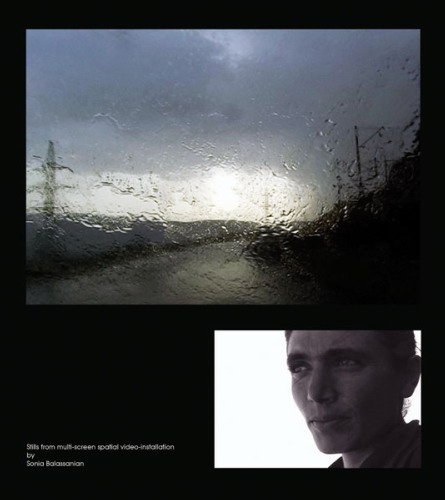Sonia Balassanian
dal 7/6/2007 al 20/11/2007
Segnalato da
Armenian Center for Contemporary Experimental Art
7/6/2007
Sonia Balassanian
Palazzo Zenobio, Venezia
Pavilion of the Republic of Armenia. Who Is the Victim? The media confront us daily with an excess of brutal war imagery. Yet the information content that these media images convey concerning specific conflicts is thin. The video images on show tap into this universalized misery and suffering.

Pavilion of the Republic of Armenia
Who Is the Victim?
The media confront us daily with an excess of brutal war imagery. Yet the information content that these media images convey concerning specific conflicts is thin. In particular since war has ceased to refer exclusively to war between nations, but involves more complex structures and dislocations, such images present an unchanging picture of misery as a universal constant of global crisis. New conflicts, no less than protracted or abiding ones, can no longer be viewed in isolation, but are components of a global, fear-fueling apparatus of war.
The artist Sonia Balassanian’s video images tap into this universalized misery and suffering. A projection of her multipart video work “Who Is the Victim?” for the Pavilion of the Republic of Armenia at the 52nd Venice Biennale shows a man in camouflage fatigues relating his war experiences in a quiet, monotonous voice—the cold, the hunger, and brute violence. The text derives from the diary of an Armenian soldier. Not that this is conveyed in the text: the man talks of his personal experiences and of the traumata induced by war. At the same time a parallel video sets up a “dialogue”: it shows a woman overcome by grief for the husband she has lost in war.
She speaks from an abstractly experiential space, for the destination her husband failed to return from is unknown to her except via the media. But the soldier’s direct experience is no less intangible than the woman’s ideas of war based on media reports and memories of her husband. Both figures have been broken by the futility of death through war—the soldier succumbs to blank apathy, the woman to despair. Gender-specific differences in dealing with war are also brought out: while the woman is left alone with her grief, the soldier is left with a shattered psyche. The slightly unsharp black-and-white images call to mind newspaper photos and lend the subjective nature of the utterances a semblance of media objectivity.
Wars and crisis areas are a constant feature of Balassanian’s biography. Of Armenian extraction, she grew up in Iran and now lives in New York and Yerevan. Concrete political events such as the fall of the Shah in Iran in her collages “Hostages” (1980) figured in her earlier works. Balassanian’s concern in her more recent video works are the ramifications of a general war (albeit never referred to as such) being waged against the individual.
The images of places and landscapes in the second room of “Who Is the Victim?” can be read as the soldier’s and the woman’s memories. Memory assumes a central role in the lives of people who experience war and henceforth shift between two extremes, the collective necessity to remember and the individual desire to forget. Alongside “good” memories of lakes and mountains that are vaguely reminiscent of impressionist paintings, or of a horse on a beach, the videos show “bad”, fear-inducing places or occurrences such as a tunnel or a storm. The images were all shot in Armenia, and yet they too could be anywhere, having more the nature of generic images of positively or negatively connoted sites of memory.
For those who have experienced war or live in fear of one, or who live with memories of a war they actually took part in and survived, the question “who is the victim” is never far from the surface in depictions of war’s unbelievable cruelty. But what is involved when a viewer of war images takes an interest in or empathizes with human suffering in far-off conflict zones? Not only those killed by war and their relatives are the victims, but all whom the fear of war afflicts. Similarly, every viewer today, no matter where, experiences victimhood in the face of the part real, part propaganda-induced fear of the proliferating warfare represented by terrorist attacks.
But sympathy puts us in a position where we can passively shirk responsibility and ignore our own role as accessories. In the words of Susan Sontag: “So far as we feel sympathy, we feel we are not accomplices to what caused the suffering. Our sympathy proclaims our innocence as well as our impotence. To that extent, it can be (for all our good intentions) an impertinent—if not an inappropriate—response.”1 In overcoming sympathy, a potential for action is released: “Compassion is an unstable emotion. It needs to be translated into action, or it withers.”2 Like sympathy, the responsibility to resist is not just a matter for the official activities of politicized groups: it is a potential present in everyone’s day-to-day life.
The question as to how art—as producer of knowledge, as a form of activism or enlightenment—can tackle the subject of war is answered by Balassanian’s multipart video with just this notion of sympathy and the necessity of its transcendence arising from insight into the fact that the universalized suffering in question is the outcome of a global strategy of war. “Everyone is asleep, crisis is coming” is how the soldier describes the current lethargy vis-à-vis this ominous situation, thus offering a potential lead-in to critical protest against an economy of global war.
Nina Möntmann
Translated by Christopher Jenkin-Jones
Opening June 8 h 1 a.m. - 4 p.m.
Palazzo Zenobio
Fondamenta del Soccorso, Dorsoduro 2596 Venezia
Free admission



